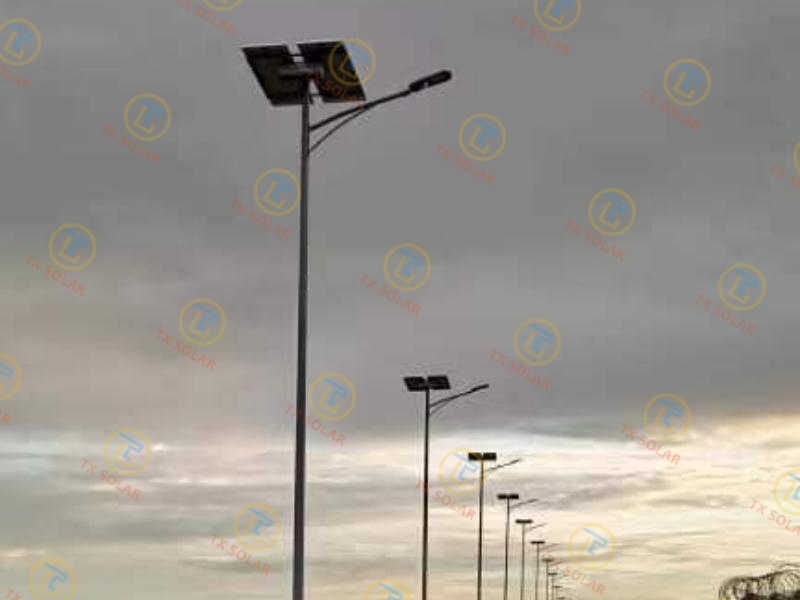Usually, the solar street light label is to tell us important information on how to use and maintain the solar street light. The label may indicate the power, battery capacity, charging time and usage time of the solar street light, which are all information we must know when using the solar street light. There may also be some tips and warnings on the label, such as children are prohibited from contact, avoid high temperatures, etc. This information can help us better use the solar street light and avoid danger. Tianxiang is a manufacturer engaged in street lighting with more than ten years of manufacturing and exporting experience. Today, I will give you a brief introduction.
1. Model: The model of the solar street light represents the unique identifier set by the manufacturer for the product.
2. Solar Panel Parameters: The label should indicate the rated power (Wp), maximum power voltage (Vmp), maximum power current (Imp), open circuit voltage (Voc) and short circuit current (Isc) of the panel. When choosing, pay attention to the life, UV resistance and waterproof performance of the panel.
3. Battery Type and Parameters: The battery is the core component of the solar street light and affects the service life of the street light. The label should indicate the rated voltage (V), rated capacity (Ah), maximum charging voltage (V), maximum discharge voltage (V), cycle life and other parameters. When purchasing, consider the reliability, charging and discharging efficiency and low temperature performance of the battery.
4. LED Light Source Parameters: The label of the LED lamp should include the rated power (W), luminous flux (lm), color temperature (K) and light efficiency (lm/W), etc. Choose the appropriate LED lamp according to actual needs.
5. Controller: The controller is responsible for the charging and lighting control of the solar street light. The label should indicate the waterproof level, charging control method, lighting time setting and other functions. Consider the stability and compatibility of the controller when purchasing.
6. Light pole and base: The label should include parameters such as the pole material, height, and base size. Consider the wind resistance of the pole, the stability of the base and the ease of installation when purchasing.
7. Working Mode: The working mode of the solar lamp, such as all-night lighting mode, induction mode (such as infrared induction, radar induction) or timing mode, etc.
8. Lighting Time: The time that the solar lamp can continue to illuminate when fully charged, usually in hours.
9. Charging Time: The time required for a solar street light to charge under sunlight, usually in hours. Waterproof Level: The waterproof level of a solar street light, such as IP65, IP66 or IP67. The higher the waterproof level, the stronger the solar street light’s ability to protect against water and dust.
10. Material & Appearance: The main material of the lamp (such as aluminum alloy, ABS plastic, etc.) and the appearance design.
11. Installation Method & Height: The installation method of the solar street light (such as wall-mounted, column-mounted, etc.) and the recommended installation height.
12. Operating Temperature Range: The temperature range that a solar street light can withstand under normal working conditions. For example, a typical solar street light may have an operating temperature range of -20°C to 60°C.
13. Warranty Information: The warranty period of a solar street light, usually including product quality warranty and performance warranty. The warranty period usually covers manufacturing defects, material problems, and performance degradation under normal use conditions.
14. Manufacturing Date: The manufacturing date of the solar street light, which helps to understand the newness of the product.
15. Application Scenarios: The scenarios or environments where the solar street light is suitable, such as road lighting, garden lighting, park lighting, etc.
16. Installation & Usage Notes: Things to pay attention to when installing and using solar street lights, such as avoiding blocking the solar panels, cleaning the solar panels regularly, and installing the batteries correctly.
Understanding these parameters is crucial to choosing the right solar street light to meet the needs of specific scenarios and ensure the safe and efficient use of the product. At the same time, in actual use, following the guidelines and suggestions provided by the manufacturer is also the key to maintaining the performance and extending the life of the solar street light.
Tianxiang, as a solar street light manufacturer, has a complete production line, complete equipment, and is online 24 hours a day. Welcome to consult!
Post time: Apr-15-2025





